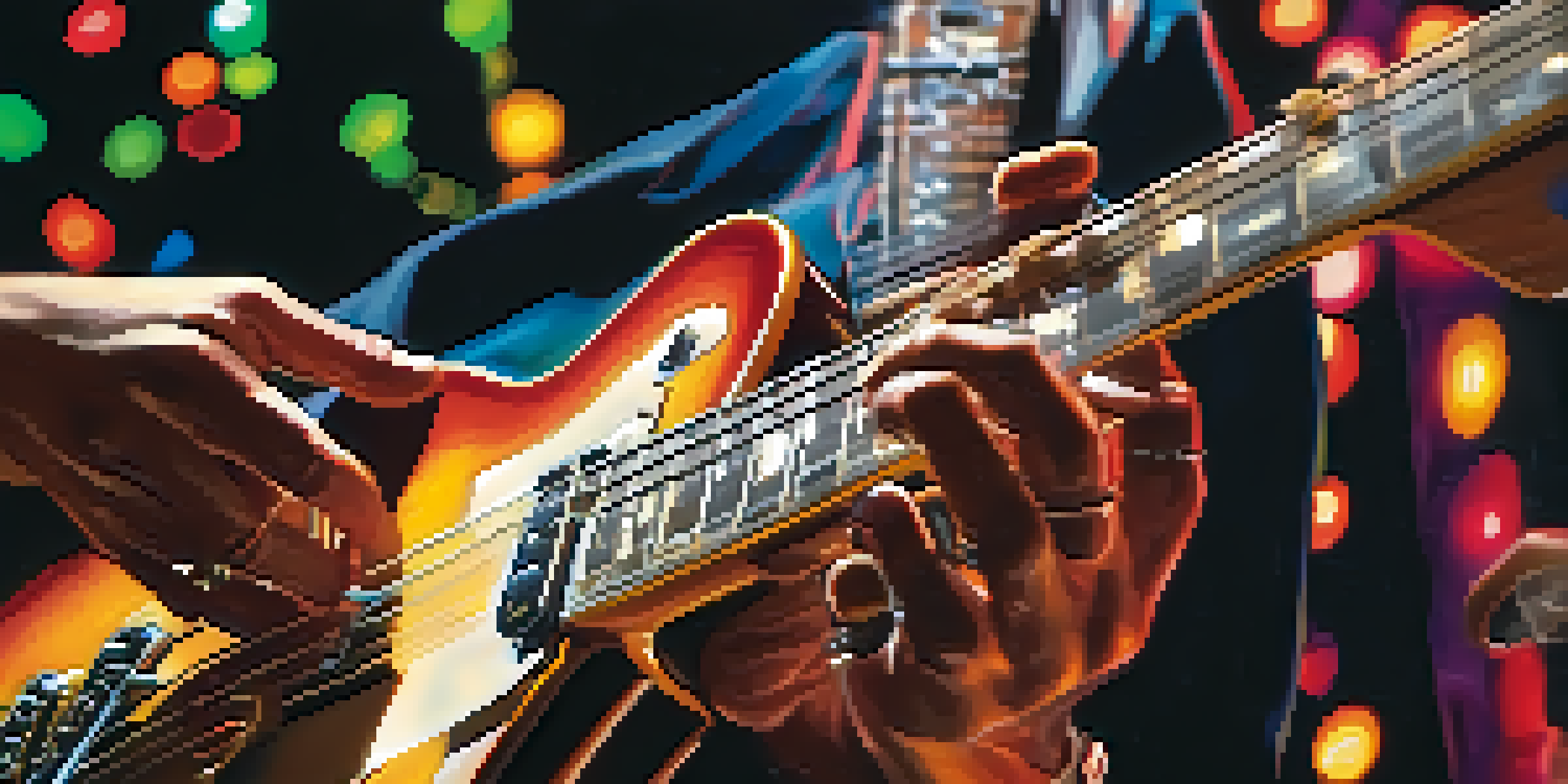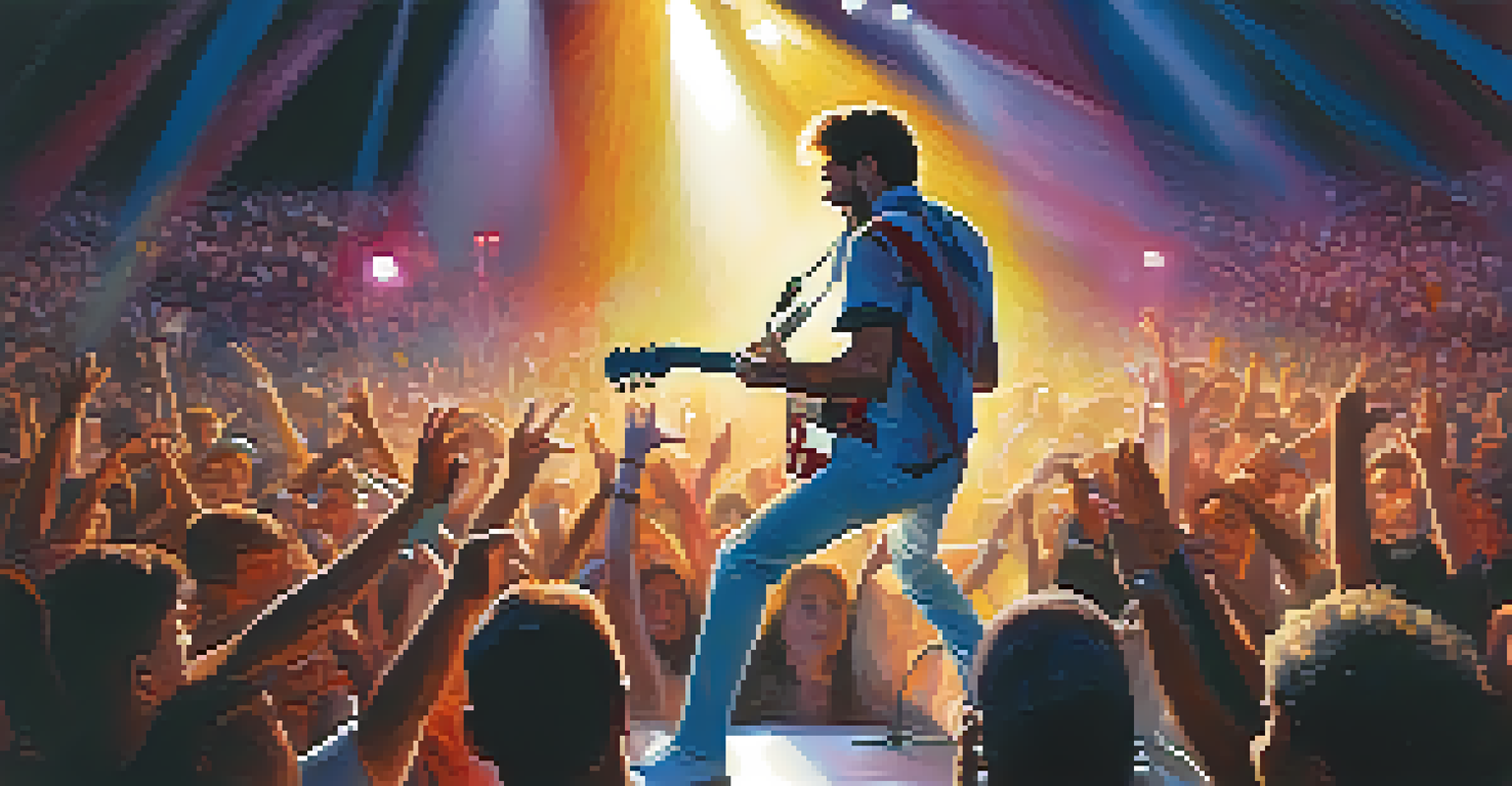The Power of Dynamics: Conveying Emotion Through Guitar Play

Understanding Dynamics in Guitar Playing
Dynamics in guitar playing refer to the variations in loudness and intensity that a musician uses to express emotion. Just like a painter uses different brush strokes to convey feelings, guitarists manipulate their playing volume and articulation to create a mood. Whether it's a soft, whisper-like strum or a powerful, aggressive riff, dynamics help in shaping the emotional landscape of a piece.
Music is the shorthand of emotion.
When you listen to a guitar solo, pay attention to how the notes swell and recede; this is the dynamic range at work. The ability to shift from soft to loud can take listeners on a journey, evoking joy, sadness, or even nostalgia. It’s this emotional connection that draws people into the music, making dynamics a powerful tool in a guitarist's arsenal.
Ultimately, dynamics are not just about making noise; they are about storytelling. A well-executed dynamic shift can be akin to a plot twist in a novel, keeping the audience engaged and emotionally invested in the performance.
The Role of Articulation in Expressive Playing
Articulation refers to how notes are played, including techniques like hammer-ons, pull-offs, and slides. These techniques add texture and character to the sound, enhancing the emotional impact of the music. For instance, a hammer-on can create a sense of urgency, while a gentle slide may evoke a feeling of longing or sadness.

Much like how a speaker emphasizes certain words for dramatic effect, guitarists use articulation to highlight specific notes within a melody. This not only makes the music more engaging but also allows the player to inject their personality and feelings into the performance. When a musician articulates intentionally, they invite the audience to feel along with them.
Dynamics Shape Emotional Expression
Guitar dynamics, through variations in loudness and intensity, play a crucial role in conveying emotion and enhancing the storytelling aspect of music.
Incorporating varied articulation techniques can transform a simple melody into a profound emotional experience. This is why listening closely to a guitarist's articulation can reveal the depth of their emotional expression, making it a crucial element of dynamic playing.
The Emotional Spectrum of Guitar Genres
Different genres of guitar music evoke distinct emotions, showcasing the versatility of the instrument. For example, the blues often expresses feelings of heartbreak and struggle, while rock can convey excitement and rebellion. Each genre has its own dynamic characteristics that contribute to its emotional palette.
The guitar is a miniature orchestra in itself.
Consider how a gentle fingerstyle arrangement in folk music can create an intimate atmosphere, inviting listeners to reflect on their own experiences. In contrast, a heavy metal breakdown might unleash raw energy, igniting a sense of empowerment or adrenaline. By understanding these genre-specific dynamics, guitarists can tailor their playing to match the emotional tone they wish to convey.
Exploring various genres can also inspire guitarists to experiment with their own emotional expression. By blending elements from different styles, musicians can create unique sounds that resonate with their personal experiences and feelings, further expanding the emotional reach of their music.
Creating Contrast for Emotional Impact
Contrast is a powerful element in music that can heighten emotional response. By juxtaposing loud and soft sections, or fast and slow passages, guitarists can create tension and release, drawing listeners deeper into the musical experience. Think of it as the ebb and flow of ocean waves, where the calm is just as important as the storm.
For instance, a sudden shift from a soft, melodic intro to a loud, aggressive chorus can evoke surprise and excitement. This contrast keeps the audience on their toes, making them more emotionally engaged with the music. It’s this element of unpredictability that can make a performance truly memorable.
Articulation Adds Musical Depth
Techniques like hammer-ons and slides enrich the sound, allowing guitarists to inject their personality and feelings into their performances.
Using contrast effectively allows guitarists to tell a story through their music. Just like the peaks and valleys of a narrative arc, the interplay between different dynamics leads listeners through a range of emotions, making the experience richer and more impactful.
The Art of Timing in Emotional Expression
Timing plays a crucial role in how emotions are conveyed through guitar playing. The way a musician places their notes, whether ahead of or behind the beat, can significantly impact the emotional delivery. For example, playing slightly behind the beat can create a laid-back, relaxed feel, while hitting the beat directly can inject urgency and intensity.
Consider how a well-timed pause can amplify the emotional weight of a phrase. Just as a dramatic silence in a film can heighten tension, a moment of silence on the guitar can invite reflection and anticipation. This interplay of timing and dynamics adds layers of complexity to the performance.
By mastering timing, guitarists can manipulate the emotional flow of their music, leading listeners through a rollercoaster of feelings. This skill not only enhances technical proficiency but also deepens the emotional connection between the player and the audience.
Using Dynamics to Enhance Songwriting
Dynamics are not just for performance; they also play a vital role in songwriting. When crafting a song, considering where to place dynamic shifts can create an emotional journey for the listener. A well-placed crescendo can build anticipation, while a sudden drop can evoke surprise or introspection.
Think about your favorite songs and how they use dynamics to tell a story. Perhaps a soft verse gradually builds into a powerful chorus, reflecting the emotions of the lyrics. This intentional use of dynamics can transform a basic melody into a compelling narrative, making it resonate more deeply with the audience.
Contrast Elevates Emotional Impact
Juxtaposing loud and soft sections in music creates tension and release, engaging listeners and making performances more memorable.
As songwriters, embracing the power of dynamics allows you to create music that truly speaks to the heart. By experimenting with different dynamic techniques, you can elevate your songwriting and connect with listeners on a more profound level.
The Emotional Connection Between Guitarist and Audience
The relationship between a guitarist and their audience is built on emotional connection, often facilitated by dynamics. When a guitarist pours their heart into their playing, the audience can sense that authenticity, creating a shared emotional experience. This bond is what makes live performances so powerful and memorable.
Consider how a guitarist might respond to the energy of the crowd, altering their dynamics to reflect the audience's mood. This interaction can amplify the emotional impact of the performance, making the audience feel like participants in the musical journey. It's a beautiful dance of energy and emotion.

By understanding the emotional power of dynamics, guitarists can not only enhance their performances but also forge a deeper connection with their audience. This shared experience is what keeps people coming back for more, allowing music to transcend mere entertainment and become a meaningful exchange of feelings.